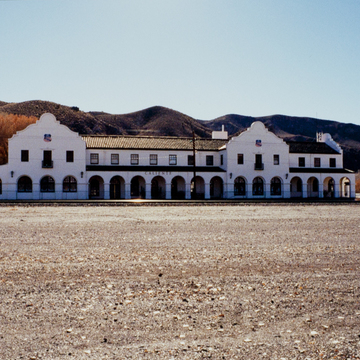Many railroads in the West favored the Mission Revival style for stations because it drew inspiration from the region's Hispanic past and evoked images of the old West to travelers. Caliente's Mission Revival depot is the largest building in town. Because Caliente served as a division point, the building had to be large enough to accommodate a hotel and restaurant, waiting rooms, offices, and storage areas. The plan is asymmetrical, with two projecting wings topped by scrolled parapets characteristic of the Mission Revival style. Two arcades, one connecting the wings and the other running along the front of the waiting room, also add visual interest. The walls are stuccoed; red tile covers the gable roofs.
Los Angeles architects John and Donald Parkinson designed more than 100 structures in southern California, including, in Los Angeles, the city hall (1926), Bullocks Wilshire Department Store (1929), and the Union Passenger Terminal (1939), the last great metropolitan train station constructed in the country.
In 1970 Union Pacific turned over the depot to the city of Caliente on a long-term lease. The depot now houses city offices, the public library, the waiting room for Amtrak, and other tenants. Upstairs rooms accommodate classes offered through the Clark County Community College system.
Next to the depot stands a radiation monitoring station, part of a network surrounding the Nevada Test Site, installed by the U.S. Department of Energy to measure background radiation in the environment as well as to increase public awareness of the results of such testing. The complex array of instruments is a reminder of the continuing legacy of atmospheric testing.








